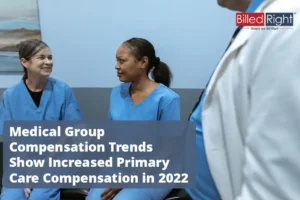The No Surprises Act Part 2 – Second Interim Final Rule Released

Background
In part one, we discussed exactly what the “No Surprises Act” (NSA) is. Passed as part of the Consolidation Appropriations Act of 2021 in December of 2020, the NSA is aimed at eliminating large unexpected or surprise medical bills. Those bills usually come from one of three sources – 1) an emergency where a patient was unable to utilize an in-network facility or 2) was able to get to an in-network emergency facility however one of the attending practitioners was out-of-network or 3) an out-of-network air ambulance. Any one of these situations can result in what is called “balance billing” or billing for the remainder of what the insurance company didn’t cover. These bills can be large and come as a surprise to the patient. The end result of NSA is that patients will only have to pay the cost-sharing portion they would normally have paid if the provider would have been in-network.
No Surprise Act Interim Final Rule II
When part one of this blog series was written, the initial Interim Final Rule with comment period (IFR) had been released, but there were still details that needed to be defined for a clear path for settling disputes. As of September 30, 2021, the Department of Health and Human Services, Department of Treasury, Department of Labor, and the Office of Personnel Management released Interim Final Rule II. Not only does this address the independent dispute resolution (IDR) process, but also the interaction of state and federal surprise billing laws, the good faith estimates for uninsured patients, and the patient/provider dispute resolution (SDR) process.
In addition to releasing the IFR, the agencies have established a portal that provides information about the law. It is also where an organization can apply to be an independent dispute resolution entity and where the IDR process for providers and payers can be started.
Independent Resolution Process
In the first IFR, the ground was laid for a provider and payer to establish a 30-day negotiation period, should they not agree on the payment amount or if the payer denies payment completely. If they are unable to agree on a payment amount in that 30 days, one of them can initiate an IDR. This would then bring in a third-party arbitrator to settle the matter. However, it didn’t outline how payment amounts would be determined.
The interim final rule part II (IFR) establishes more details for the IDR process that providers and payers may use. As stated in the first IFR, the two sides can jointly pick a certified IDR entity to resolve the payment dispute. If they are unable to agree on an IDR entity, one can be appointed. Both sides then provide their suggested out-of-network payment rate to the IDR entity for them to review. Part two of the IFR states that the IDR entity has to begin with the presumption that the Qualifying Payment Amount (QPA) is the right amount. Understanding that the QPA is determined based on the average contracted in-network rates in the geographic area for the same or similar medical services.
The IFR also acknowledges that there are other factors including experience, how complex the procedure or medical decision-making was, that can also be factored in. However, to present pricing that is different from the QPA the provider must also present evidence that the QPA is “materially different” from the OON rate. The IDR entity has 30 business days from its selection to choose what the approved rate is, based on the offers submitted, in a baseball-style arbitration. One or the other offer has to be chosen. The entity can’t split the difference. Once a decision has been made a written decision is handed down, and if the rate that is chosen is not closest to the QPA, the IDR entity must include an explanation of the documentation that led to the contrary decision. The IDR entity’s decision is binding and not generally subject to judicial review except in the case of fraud.
And once the decision is handed down the Dept. of Health and Human Services is required to publish all the details about each IDR arbitration, including the names of the parties, payment offers made by each party, and the final resolution.
There are also provisions that the party who submitted the IDR cannot involve the same party again for the same, or similar items or services, for 90 calendar days after the determination. This was established in hopes that should another issue arise the two parties would be able to negotiate a settlement before initiating an IDR.
State Law vs Federal Law
The IFR includes information on how state laws on surprise billing and the new federal law will interact. The rule specifies that when a state has a law that provides patient protection that is equal to or more than the federal law it will take precedence. In addition, the states will play a large role in the enforcing of the new federal surprise bill law, with HHS only stepping in when a state either doesn’t have the authority to enforce or isn’t enforcing a no surprises law.
Good Faith Estimates
The rule also establishes that providers or facilities issue a good faith estimate of charges for medical services to a patient who is uninsured or is going to be self-pay. This must be a list of items and/or services that can be expected in conjunction with the scheduled or requested service in understandable language. The estimate is expected to include charges and costs from all providers and facilities that are providing items or services. There are not to be separate estimates from individual facilities or providers. This estimate must be provided no more than three business days after the request for a good faith estimate is made or service is scheduled, as long as it is scheduled more than three days out. Should something change the patient is to be notified as soon as possible. If something on the estimate changes less than one day before the scheduled service, the new provider will have to accept the prior good faith estimate pricing.
Should, after the service is rendered, a bill come in that is $400 or more above for any provider or item on the good faith estimate the IFR also set guidelines for a Selected Dispute Resolution (SDR). This is where a self-payer can dispute the excessive charge. To initiate the dispute, the individual needs to send an initiation notice to HHS through the federal portal, or via a form through the USPS within 120 calendar days of receipt of the bill. Once an SDR has been started the provider or facility must not continue any collection efforts, accrual of late fees, or take any retaliatory action. The SDR entity will review the bill, good faith estimate, and any other documentation outlining the differences between the two that reflects the costs of something that ended up being medically necessary or a service that couldn’t have been reasonably anticipated at the time the good faith estimate was issued. The SDR entity has 30 days, once all documentation has been submitted, to make a determination and that determination is binding to all parties.
Additional Provisions
In addition to the specific rules around surprise billing, this IFR also provides some additional provisions aimed toward payers in an effort to help patients.
Transitional Coverage
The law also now mandates that health plans provide transitional continuity of coverage, for certain patients, when a provider leaves a network. The health plan must notify a patient or enrollee when a provider or facility is no longer affiliated with the plan network while they are providing care. In some cases, the plan must also provide 90 days additional coverage or until treatment ends, whichever is earlier, at in-network rates. This gives a patient time to either complete treatment or to find a new, in-network provider to transition to.
This mandate applies to treatment for serious or complex health issues, in-patient care, non-elective surgery, pregnancy, and treatment for terminal illnesses.
Accurate Provider Directories
Although health plans have directories of in-network providers, sometimes the information is out of date and a provider that is listed is no longer associated with the network. Health plans will now have to establish a verification process to update their provider directories information at least every 90 days. They will also have to respond within one business day to inquiries regarding if a provider or facility is in-network. This information, once given, becomes binding. Meaning that a patient who makes a decision based on the information given by their health plan, or posted in a directory, is entitled to having any services covered at the in-network rate.
What Does This Mean for Revenue Cycle Management?
In addition to protecting patients against surprise billing, on the other side, this law will especially affect revenue cycle management leaders. They will need to be prepared for these changes by:
- establishing processes to provide good faith estimates promptly
- stop balance billing
- be prepared to negotiate with payers
- understand that arbitration costs money
- continue to stay updated on the rules for how the law will be enacted
- do a financial assessment to understand what impact the law will have on overall reimbursement
- training of staff to deal with patient questions
All of this will need to be in place by January 1, 2022, when the law goes into effect.
_________________________________________________________________________________
Who is Billed Right?
In 2006, two business partners had a vision of creating holistic services that can help improve medical billing operations. They started by listening to doctors and building a service model around what doctors need the most. As a result, Billed Right’s Revenue Cycle Management (RCM) model was born. The focus continues to be on solving the problem, rather than selling a product, and hence, Billed Right’s advanced RCM model revolves around personalized service in today’s corporate world, while still cutting costs and improving both patient care and practice revenue. No matter what challenges physicians face, we never waiver from our goal to be a partner in strategy to promote practice growth.
Contact Billed Right to learn more.







